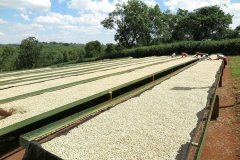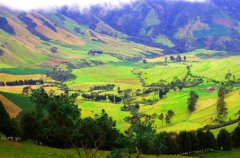Six major producing areas in Bolivia introduce Pro-Agro coffee cooperative in detail
The coffee growing areas of Bolivia (Bolivia) include Yungas, Santa Cruz, Beni, Cochabamba, Tarija, Pando, etc., but the vast majority (95%) are produced by Yungas.
The local government expropriated land from the big landlords and redivided it into 1-8 hectares.

Distributed to coffee farmers for planting
These small farmers account for about 85-95% of Bolivia's coffee production.
Most of them are Arabica species and are grown organically.

Bolivia has high-altitude mountains, rich soil and stable rainfall.
However, in the past, due to inconvenient transportation and backward processing technology,
The quality of raw beans has always been difficult to control.

But in recent years, with the construction of transportation highways,
The establishment of various cooperatives and the introduction of new concepts and technologies
So that Bolivian coffee can also squeeze into the global coffee market.
High-quality Bolivian coffee tastes thick and fruity.
Pro-Agro Coffee Cooperative in Bolivia
Caranavi located in Yungas producing area
Made up of 250 small coffee farmers

The average coffee farmer has about 3 hectares of land to grow organic coffee.
Like ordinary Bolivian coffee.
Because it is produced by small farmers.
In the raw beans of the Proago Cooperative.
There will be a certain degree of round beans (PB) and a few different varieties of raw beans in it. The taste of sweet and sour is balanced and the aroma of wood is quite good. It feels similar to the CIAPEC I drank before. And this raw bean is very cheap, less than 300 a kilogram.
Important Notice :
前街咖啡 FrontStreet Coffee has moved to new addredd:
FrontStreet Coffee Address: 315,Donghua East Road,GuangZhou
Tel:020 38364473
- Prev

Peru Villa Rica (Villarica Manor) SHG Organic Coffee Bean planting introduction Flavor description
Peru Villa Rica (Vilarika Manor) SHG Organic Coffee beans the coffee growing area in Peru is mainly located in the central Chanchamayo region, the two most famous planting areas in this area are Villa Rica and La Merced, respectively, and the main varieties are Typica Arabica. The history of Peruvian coffee cultivation dates back to about 1930 when a group of Germans emigrated to Villa Rica District to open coffee.
- Next

Columbia Colombia coffee bean roasting record selection and classification of the main producing areas detailed introduction
Colombia's geographical and climatic conditions are more suitable for coffee than Brazil, and coffee is produced almost all over the country from south to north. Once upon a time, Colombian Tibica was all the rage. Unfortunately, after the interest-oriented atmosphere swept through, Colombia now focuses on the production of commercial beans with mediocre flavor. We should not self-righteously say that coffee farmers are wrong, after all, people need to be the first.
Related
- Does Rose Summer choose Blue, Green or Red? Detailed explanation of Rose Summer Coffee plots and Classification in Panamanian Jade Manor
- What is the difference between the origin, producing area, processing plant, cooperative and manor of coffee beans?
- How fine does the espresso powder fit? how to grind the espresso?
- Sca coffee roasting degree color card coffee roasting degree 8 roasting color values what do you mean?
- The practice of lattes: how to make lattes at home
- Introduction to Indonesian Fine Coffee beans-- Java Coffee producing area of Indonesian Arabica Coffee
- How much will the flavor of light and medium roasted rose summer be expressed? What baking level is rose summer suitable for?
- Introduction to the characteristics of washing, sun-drying or wet-planing coffee commonly used in Mantenin, Indonesia
- Price characteristics of Arabica Coffee Bean Starbucks introduction to Manning Coffee Bean Taste producing area Variety Manor
- What is the authentic Yega flavor? What are the flavor characteristics of the really excellent Yejasuffi coffee beans?

